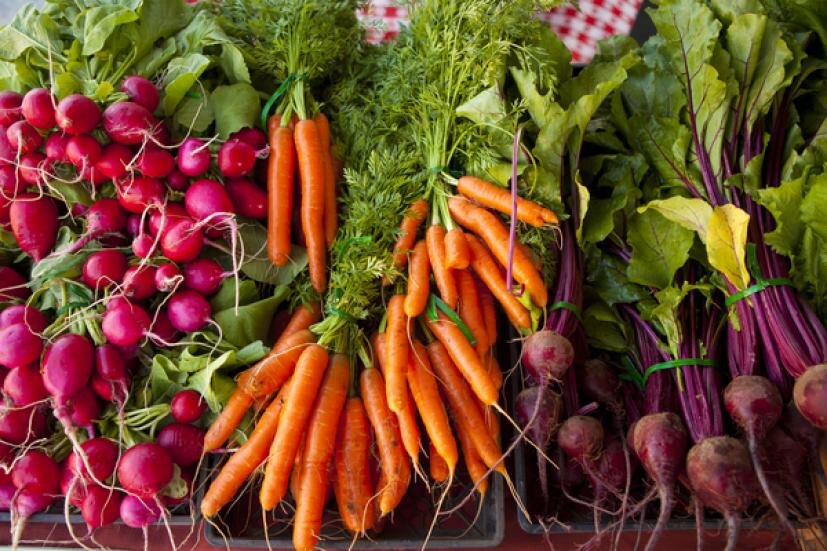Local Food:
Growing our Resilience in a Changing Climate
Producing and preserving food close to where we live and ensuring that everyone in the community has access to good food: this is what we mean by local food resilience.
These practices are climate solutions, helping to mitigate the impacts of the climate crisis while adapting our community to changing ecological and economic conditions.
THE LOCAL FOOD / CLIMATE CRISIS CONNECTION
Due to the Earth’s changing climate, our home region faces increasing likelihood of wildfire, drought, and flooding. These threats, alongside others such as earthquakes and pandemics, can impair the reliability, accessibility, and quality of our food supply. Because climate change jeopardizes the food supply and raises the cost of food, equity issues are even more pressing. The local community has an important role to play in addressing these challenges. To strengthen our local food resilience, we share resources and expertise and promote opportunities for action.
Producing and preserving food close to where we live:
Transporting and refrigerating food grown in other bioregions requires the use of fossil fuels. Consuming food grown locally (including in our own gardens) significantly reduces our food’s carbon footprint.
We encourage the practice of organic or near-organic methods. Examples include relying on compost and other organic soil amendments rather than synthetic fertilizers, reducing the use of chemical pesticides, and growing cover crops to add nitrogen to the soil. Organic food requires substantially fewer energy inputs than conventionally grown food does.
Ranchers, farmers, and home food gardeners alike can “farm carbon” by building healthy soil that is rich in organic matter. Soil stores the carbon which green, growing plants absorb from the atmosphere. Soil rich in organic matter is highly productive and efficient at retaining moisture, decreasing the amount of watering that plants need. (Gordon Bryan’s Garden featured on the right).
We promote water catchment and conservation strategies. Producing and distributing drinking water has a significant carbon footprint, or climate cost. Reducing the use of potable water in our gardens and farms and/or using captured rainwater are ways to reduce the carbon footprint of foods that we grow.
We encourage home composting and use of our green bins, from our waste hauler, for all food and plant waste (including meat). It is essential to keep organics out of the landfill, where they emit methane, a potent greenhouse gas.
We promote a robust 12-month gardening cycle, which is possible in the West Marin bioregion with our mild winters. Gardening year-round can maximize local food production and efficiency of land resources.
To adapt our gardening practices to warming temperatures and more erratic precipitation patterns brought by climate change, we provide workshops and information resources including:
Edibles that are suitable for local microclimates (listed here); varieties that mature more quickly, are drought-tolerant, and are heat-tolerant; and the benefits of less thirsty perennials.
Best earth-friendly cultural practices
Ensuring that everyone in the community has access to good food:
Ensuring that everyone in the community has access to good food:
We promote donation of extra harvest to our local food pantries.
We participate in gleaning activities, including post-harvest gleaning (gathering quality crops that are surplus) in gardens, small farms, and orchards, invited by the landowners, in partnership with ExtraFood.
Sharing or distributing gleaned food locally helps to ensure that more community members have access to healthy food, and that farmers and other growers have the people power to harvest all the food available. Importantly, gleaning reduces food waste – greatly improving return on the energy inputs that it took to produce the food. Insert photo of gleaning for ExtraFood
We partner with the Point Reyes farmers market to encourage customers to “Buy One, Donate One” – creating a supply of high-quality produce for our local food pantries to share with community members.
We search for ways to create shared garden spaces for community members who do not have access to land for growing food.
Click here for Food Gardening Resources, including a list of recommended edible varieties, links to recorded webinars, and online and print resources.
We are all about action! Click here for Local Food Actions You Can Take to help mitigate the impacts of the climate crisis while adapting our community to changing ecological and economic conditions.
Water
As we face water shortages from drought, we will be asked to conserve our consumption of public and private water sources. This year is looking especially worrisome as we have received only 30% of the normal rainfall for this time of year. Climate change is increasing average summer and fall temperatures during the dry season, and could cause more severe drought conditions in coming years. Local food resilience goes hand in hand with water conservation. We will need to employ new strategies to collect and conserve water for our gardens.
Examples of Water Catchment Systems
Some of our neighbors have installed water catchment systems at their homes. You can see one example in a video on our Events page.
Here’s an example from a home in Inverness. These are food grade, 275 and 325 gallon IBC tanks: 48”x40”x46”. (On Craigslist, $99 each).
Marin Municipal Water District offers rebates of up to $0.50 per gallon of storage.
We’d love to see more local examples. Please share photos and a short description of your water catchment system. It may help others to consider and install their own. Send to westmarinclimateaction@gmail.com.





